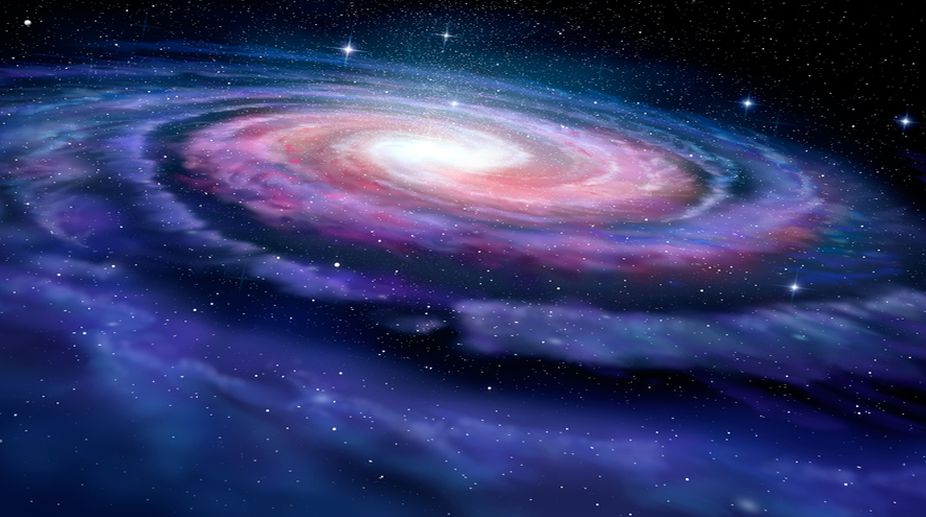The reason we have such brightness when the sun is shining on the earth is that the atmosphere scatters light at us from different directions. If we did not have an atmosphere, everything in direct sunlight would be very well lit but we could not say the same about things in the shade. The sky overhead would be dark, and there would be stars, even more clearly than usually at night.
However, as we do have an atmosphere, we can see very little of the real blackness of outer space while we are on Earth. This is so even when we are above the atmosphere, because there is still scattering by interplanetary dust in the near solar system. Michael Zemcov, Poppy Immel, Chi Nguyen, Asantha Cooray, Carey M Lisse and Andrew R Poppe, from Rochester Institute of Technology, University of California, John Hopkins University and Jet Propulsion Laboratory, California describe in the journal, Nature Communications, the study of interstellar illumination conducted at a great distance from the earth. The study used instruments on Nasa’s spacecraft, Deep Horizon, beyond the orbit of Jupiter, on its way to Pluto, precisely to escape the glare that persists at shorter distances.
Advertisement
The faint light that is there in the blackness of deep space, the so-called Cosmic Optical Background (abbreviated as COB), is the sum total of the radiation from all the light emitting objects in the universe, after taking away the contribution from the solar system and our own galaxy. Although there are a great many of such external objects, they are distributed at such large distances that their effect in the spaces between them is extremely faint. It is this extreme faintness that makes the light so difficult to isolate and detect.
An accurate measurement of this faint glow, however, is of great interest, to test our current theories about the nature of the universe. We have a certain estimate of the number of luminous objects, and their distances apart, which lead to a certain level of illumination. If what we measure turns out to be different, then we may need to change our ideas of where the light comes from.
On the other hand, it is with the help of the faint background light that we make some of the estimates of the count of luminous objects in the heavens. If we have confidence in the amount of light from known objects, or the foreground light — in some direction — we could estimate the background light. We could then use this to work out the foreground light, from the total light coming in from another direction. The whole exercise, however, depends on measurement of the illumination itself, which is difficult in the level of glare in near-Earth locations makes. The background illumination is believed to arise from different processes in the universe. These processes include the star formation process and, after the stars are formed, the nuclear fires in stars, where atoms of elements are generated by fusion of the nuclei of atoms of lighter elements. Another source of radiation is the matter near black holes, which accelerate to near the speed of light as they crash into the black holes. Yet another source is emission, as the nuclear fuel in the larger stars runs out and the stars collapse, because of their own gravity. And then there is the emission from events like the decay of elementary particles, or the effect of particle annihilation or acceleration.
Most of the early deep space missions sent out, the paper says, had rudimentary optical range cameras and did not make useful observation of the intensity of the COB. The probes, Pioneer 10 and Pioneer 11 (1972-73), however, had specialised equipment but the results were still uncertain as the foreground components to be subtracted were themselves uncertain. It was Nasa’s New Horizons, the craft (launched in 2006) that flew by Pluto in 2015, which sent far superior data that the present researchers have analysed.
New Horizons was equipped with Lorri, the Long-Range Reconnaissance Imager, a camera primarily meant to analyse geological features of Pluto. The high sensitivity and ability to resolve narrow angles, however, could eliminate much of the starlight foreground that had confused earlier measurements and the mission collected relatively undisturbed data about the diffuse astrophysical emission or COB. The authors of the paper bring out that over the cruise of the spacecraft — beyond the orbit of Jupiter, at 779 km from the sun, on its way to Pluto at 5.9 billion km — there was data about COB measured from a range of vantage points.
Ninety days after the craft was launched, the Lorri camera recorded a series of measurements, with the camera shutter on or in total darkness. The shutter was removed about six months after the launch and a known open star cluster was imaged. The image that was acquired enabled the camera to calibrate, so corrections could be applied to faint measurements to be made later. Data was then recorded till July 2014, about a year before the encounter with Pluto.
The paper explains that the brightness of an image of the sky outside the atmosphere consists of several components. It arises because of interplanetary dust, with clearly visible stars; starlight from sources that cannot be made out, a component of “diffuse galactic light” and then the COB. With the help of the different sets of data acquired, the team could “correct for dark current in the detectors, mask bright stars from the images, assess the amplitude of residual starlight, sunlight from interplanetary dust and diffuse galactic light, and correct for galactic extinction,” the paper says, to arrive at a statistical upper limit of the value of COB.
The results show the effectiveness of the Lorri arrangement to make precise, low foreground measurements of the COB, the paper says. A future mission could hence be designed to yield a much more accurate upper limit of the COB, which could help us “complete our understanding of the history of stars and galaxies in the universe,” the paper says, “While we have estimates of these processes and of how intense the COB should be, finding the COB to be different may reveal the presence of exotic forms of matter or of decay of particles other than those that fit into the Standard Model.”
The writer can be contacted at response@simplescience.in.











